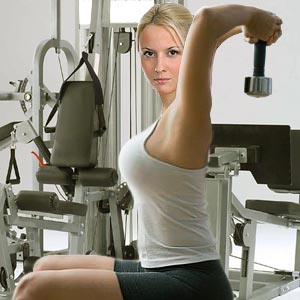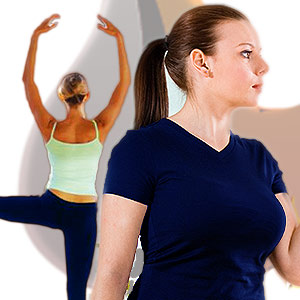Plyometric Exercises

Specific types of exercises that require the use of powerful and fast movements are referred to as 'plyometric', or 'plyos'. Plyometric exercises help to improve the functions of the nervous system. Plyometric exercises are extremely effective to gain muscle tone and definition rather quickly.
No wonder then plyometric exercises are increasingly used in performance sports; where a muscle is loaded and then contracted in rapid sequence to produce strength, elasticity and innervations. Thereby you are able to jump higher, run faster, throw farther, hit harder depending on the desired training goals. Explosiveness for a variety of sports can be gained by plyometric exercises.
In the US, the American Council on fitness recommends plyometric exercises, if performed properly. The National Strength and Conditioning association offers a positive stand in favor of plyometrics.
Plyometric exercises phases
Plyometric exercises involves first a set of rapid muscle lengthening movements, called eccentric phase, followed by a short resting phase, amortization phase and then explosive muscle shortening movements, the concentric phase, which enables muscles to work together in a particular motion.
Myotactic reflexes refer to automatic contraction of muscles where their stretch-sensory receptors get stimulated. The most common plyometric exercises include hops, jumps and bounding movements.
Jumping off a box and rebounding off the floor and onto another higher box is a popular plyometric exercise. Some plyometric exercises which typically bridge the gap between speed and strength and build power are described below:
Clock drill: Tape down a hexagonal area with each side 12 inches apart. Start out at the center of the hexagon and jump forward with both feet until you are over the line. Jump back exactly the same line you jumped over. Jump outward next and repeat the process over again until three rotations of plyometric drills are fully completed.
Wave run: Begin backpedaling in a diagonal motion toward left and go for 5 yards before stopping. Sprint diagonally in the same direction and then stop. Turn around so that you can backpedal to the left again for a second time and stop once more. Finally reverse the direction one more time but by running forward. Repeat this drill as often as required.
T-test: Sprint for roughly 10 yards and then touch the ground. Now shuffle to your left for about 5 yards and then repeat touching the ground again. Do the same thing on the next side but instead of doing it for 5 yards add five more to the distance and touch the ground again. Now shuffle to the middle, touch the ground and then run in a backward motion to the point originally started from.
Box runs: Sprint forward and touch the floor. Then scuffle to the right and touch the floor. Then backpedal and touch the floor for a third time. Scuffle to the left which will take you right back to the position you started from and touch the floor for a fourth and final time. Complete the drill in a 10 second time limit. The distance you run in any direction could be anywhere from 5 to 10 yards.
Drop jump: This is a lower body exercise where the person must drop down from a platform that is higher than the intended destination and then jump as soon as he/she touches the ground. By moving forward you will get a pre-stretch to your leg muscles. This portion of the exercise where the landing shock is absorbed into the legs as you bend the knees is called drop jump.
Depth jump: You have to spring from the ground right after you touch it, called overcoming. This is depth jump. You must not stay in the ground for too long because you want the motion to be as swift as possible. The elastic energy stored in the legs is put to test here. This exercise is very high in intensity and it is recommended to ensure that proper strength and preparation are made before attempting depth jumps. As for the repetitions, it is better to decide from what height to jump and fewer and lower is always better until the body responds positively.
Press up and hand clap: This is one of the many exercises available to improve the upper body. Start from push up position and push up with your hands using enough force to enable coming off the ground and clap hands while your body is extended in the air. This applies a great deal of pressure to both your chest and arms while hands come back toward the floor. So press up and again; try not to stay on the ground for too long because the faster you do the plyometric exercises the more effective it will be.
Similar to the drop jumps and depth jumps, this press up can be limited to just the yielding of gravity or to the yielding and overcoming.
Medicine ball drops: This is an upper body exercise and must be done with a partner. Lie on your back and have your face pointed toward the ceiling. Then have your partner drop a medicine ball right on you and throw it back at your partner as fast as you can. Like the other plyometric exercises, you have much better results when you do this as quickly as possible.
Plyometric exercises for football, volleyball and track
Plyometric exercises aim at stretch reflex of the muscles. They help to maximize power in the stretching and shortening cycle of a muscle or muscle group. It is the balance and strength aspect of the movements that help in optimal efficiency and help train athletes absorb the shock better. The resiliency is improved in the joints and soft tissue. An athlete is able to sustain repetitive contractions over time, or a volleyball player is able to continuously jump for a rebound. Versatile muscle joints help in a broad range of motion useful in football or volleyball.
Hence, plyometric exercises including jumps in place, standing jumps, multiple jumps, box drills, depth jumps, bounding and medicine ball exercises are used successfully by players to build power, speed, improve coordination, and agility and effectively improve sports performance.
Plyometric exercises can make a sports person can add 10 inches or more to his/her vertical jumps, move faster than ever before and outperform the strongest opponents. But it is essential to remember that such high risk exercises if performed incorrectly can increase the risk of injury.
Plyometric cardio circuit
This is a very intense forty minute workout. It is primarily designed to get the person into great shape and also shed excess weight and fat from the body. Gain incredible stamina and strength in the process, and also gain mental strength out of completing an intense workout. This creates an overall sense of wellbeing and general health.
The first step is to indulge in a warm up session. This session can last up to 10 minutes. It should start slowly and gradually build up as the minutes pass by. This is not a simple warm up and you will be left feeling tired and possibly gasping for air.
Following the warm up, the next is the stretching session. This part lasts for about 7 minutes and there is no time to rest. The stretches are very basic, so you are likely to be familiar with many of the movements. After basic stretches, advance stretches would follow.
Next comes the third and main session of the real workout. This is structured as an interval style workout and can be very challenging.
The first round has a series of four exercises; each lasting about 30 seconds. For instance, you will do a set of power squats at high intensity. Each time it is completed, one round of circuit is over and the next one will be completed at a higher intensity. This can be quite tough for those not used to this style of training.
The next round involves movements such as standing exercises, pushups and combinations of both. These again could be most challenging of all and might be difficult for many. On perseverance, the body gets acclimatized to this soon.
On completion of the third round, you are ready for the cardio cool down session. This comprises just two movements done for thirty seconds each. Another set of stretches completes the session.
The plyometric cardio circuit exercises are very challenging to say the least. It is a quick workout and tests the toughest. The entire session is for about 40 minutes. The interval training gets over quite quickly and you can recover and be ready for the next session. The intensity of the circuit can be varied according to the style of training and individual requirements.
Plyometric training
Personal health history, training experience, body weight and personal goals need to be borne in mind while prescribing a plyometric training program. It is better to restrict the training program only to those who have developed foundation for muscle strength by first participating in a general resistance training program.
Plyometric training need to start with lower intensity drills and gradually progress to higher intensity drills as techniques and performance improve. Right footwear, adequate space, shock absorbing landing surfaces and training frequency are other issues to be considered for the training program. It is also better to under train rather than over train and risk an injury.
It is imperative that fitness professionals who have experience in plyometric exercises conduct demonstrations and coaching cues in order to enhance learning, improve technique and reduce the likelihood of injury.
Exercise intensity: This varies greatly; for instance, skipping exercises are classed as low intensity while reactive drop jumps are the highest intensity of the plyometric exercises. Plyometric training should progress gradually from lower intensity to higher intensity drills especially for individuals who lack a significant strength training background.
Volume: Plyometric volume relates to the number of repetitions per session. For lower body exercises, a repetition is a ground contact.
Frequency: Typically 2-3 sessions of plyometrics can be completed in a week. Alternatively, recovery time between sessions can be used to prescribe frequency and is recommended at 48 to 72 hours.
Safety considerations
Due to stress, repeated shock tension exercises such as plyometrics, can increase the risk of injury on joints and connective tissues. The essential aspect is to develop a safe landing technique. This means the athlete lands softly on the toes and rolls to the heels. The other key to proper landing is to avoid any twisting or sideways motion at the knee.
Plyometric safety tips
- Plyometrics are recommended only for those athletes in good health.
- High level of leg strength prior to performing plyometric exercises is essential.
- Warm up thoroughly before starting plyometrics.
- Start slowly with small jumps and gradually build up.
- Land softly to absorb shock.
- Allow plenty of rest between plyometric workouts.
- If any pain if felt on the joints, stop immediately.
- Pay immediate attention to injury warning signs and symptoms.
- Use proper footwear with plenty of cushioning.
- Perform plyometrics on soft and cushioned surfaces only.
Top of the Page: Plyometric Exercises
Tags:#plyometric exercise #plyometric exercises #plyometric training #plyometric cardio circuit #plyometric workouts #plyometric exercises for football #plyometric exercises for volleyball #plyometric exercises for track

Posture Correction
Qigong Exercises
Five Tibetan Rites
Piloxing Workout
Calisthenics
Karate For Women
Self Defense for Women
Krav Maga
Circuit Training
Interval Training
Hybrid Workouts
Barre Workout
Eskrima Workout
Learn Tai Chi
Indoor Rock Climbing
Reducing Body Fat Percentage
Fat Burning Zone
PACE Progressively Accelerating Cardiopulmonary Exertion
Non-exercise Activity Thermogenesis
Women Fitness
Morning Exercise and Metabolism
Choosing Fitness Center
Fitness Center for Women
Fitness Weight Loss in women
Home Fitness Equipment
Kid Fitness
Gym Safety Tips
Building Lean Muscle
Lose Belly Fat
Flat Belly Tips
Exercises for Women

Toned Arms for Females
Hip Flexor Strengthening
How to lose Muffin Top
Plyometric Exercises
Flexibility Exercise Program
Belly Bloat
Body Sculpting Exercises
Core Strengthening Exercises
Core Strengthening Benefits
Exercise for Seniors
Fitness Exercise Articles
Anti Aging Exercise
Rebounder Exercise
Jogging Exercise
Flat Stomach Exercise
Knee Exercise
Butt Exercise
Weight Exercises for Women
Chest Exercise for Women
Stretching Exercise
Lower Back Exercise
Hip Exercises
Leg Exercise
Abdominal Exercise
Face Workout
Face Exercises Benefits
Double Chin Exercise
Eye Exercise Benefit
Thigh Exercises
Stair Climbing Exercise
Isometric Exercise
Pilates Exercise
Magic Circle Exercises
Rotator Cuff Exercises
Arm Exercise
Kegel Exercises for Women
Carpal Tunnel Exercises
Exercise Equipment
Xiser Workout
Foam Rolling Exercises
Rowing Exercise Machine
Elliptical Machine Benefits
Stepper Exercise Machine
Dumbbell Exercise
Weight Loss Calculator
Strapless Heart Rate Monitor
Home Exercise Equipment
Recumbent Exercise Bike
Resistance Exercise Band
Weight Lifting Exercise
Ball Exercise
Kettlebell Exercises
Medicine Ball Exercises
Swiss Exercise Ball
Kamagon Ball Workouts
Top of the Page: Plyometric Exercises
Popularity Index: 101,574

